*FYI - this post may contain affiliate links, which means we earn a commission at no extra cost to you if you purchase from them. Also, as an Amazon Associate I earn from qualifying purchases. Check out our Privacy Policy and Disclosure. for more info.
Famed for its stunning cathedral and tasty gingerbread, the little German city of Aachen can often be overlooked by international visitors… usually in favour of larger nearby cities like Cologne or Düsseldorf.
But for European history buffs, Aachen is a must-see. After all, Charlemagne (medieval Frankish king and Holy Roman Emperor extraordinaire), established Aachen as his principal residence and the center of his empire in the late 8th century, making it a key political and cultural hub… and over 1000 years later, we can still ogle relics from his reign. Isn’t that absolutely wild?
If your answer was a resounding “yes!” rather than a slow backing away, then I think you’d like Aachen. Otherwise, you might find it a bit boring. But hey, compact as it is, it makes a nice destination for a day or two, with a splash of student-city enthusiasm through bars and restaurants to keep you going.
In this post, I’ll be sharing the best things to do in Aachen, from cathedral crashing and fountain frolicking to museums about art, architecture, and cookies!
1. Aachen Cathedral (Aachener Dom)
Let’s get the big one out of the way – if you’re visiting Aachen, odds are you’re here to see the cathedral.
Aachener Dom (as it’s known in German) is a masterpiece of mixed architectural styles, famed for its glittering mosaics that will leave you with neck pains for days to come.
A key highlight here is the octagonal Palatine Chapel, the last piece remaining of Charlemagne’s original palace. This portion of the cathedral has been around for over 1000 years, setting the stage for dozens of German coronations over the centuries. Today, visitors can still admire Charlemagne’s throne and of course, his very shiny gold casket.
Fun fact: Aachen Cathedral isn’t just a UNESCO World Heritage site, it was among the very first batch recognized when the list was inaugurated. Yay – Bonus bragging rights.
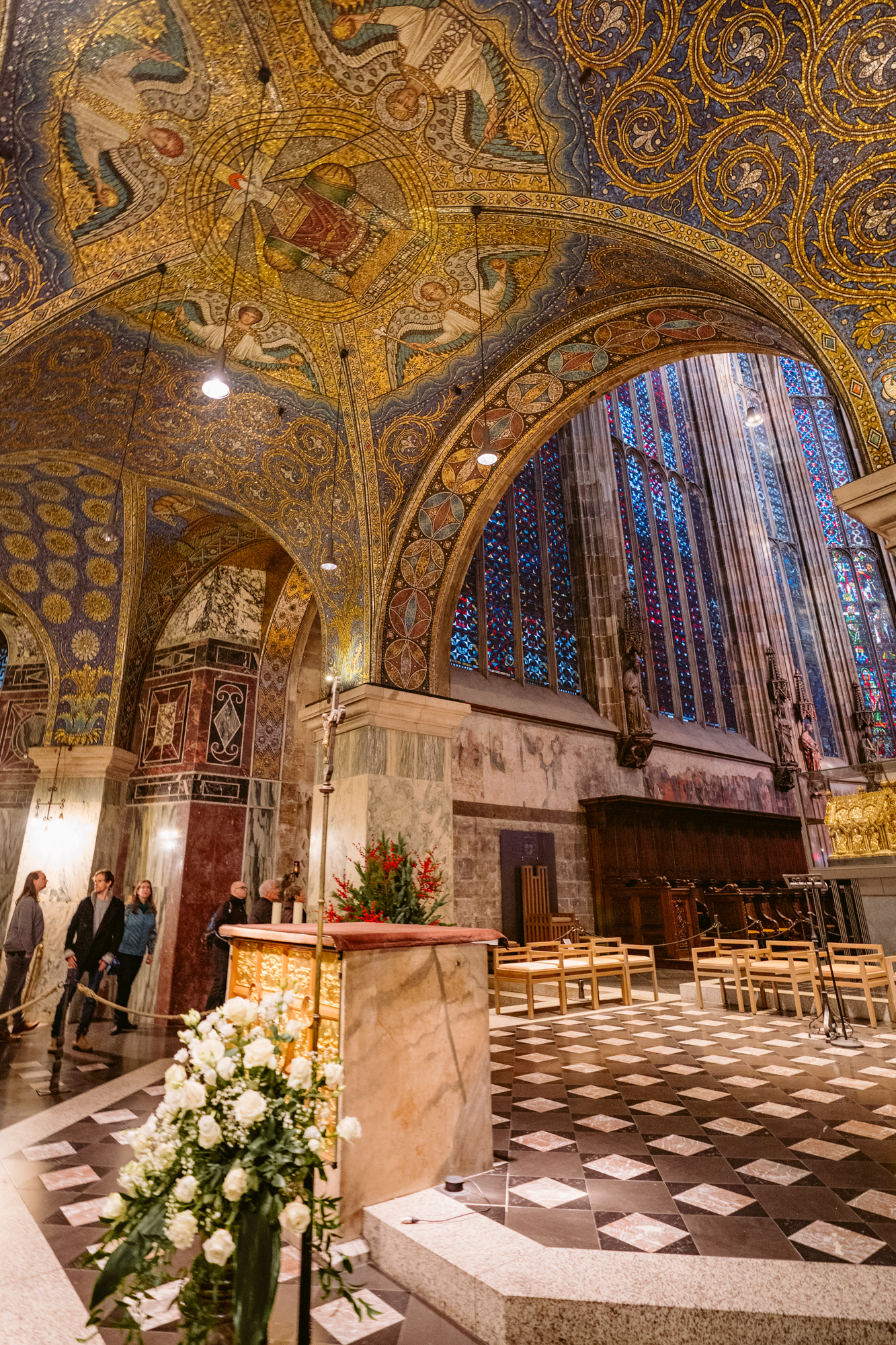

2. Aachen Cathedral Treasury
If shiny objects are your thing, another fun thing to do in Aachen is a visit to the Aachen Cathedral Treasury, home to a remarkable collection of religious artifacts, many of which date back to the time of Charlemagne.
The Aachen Cathedral Treasury’s collection includes a wide range of precious objects that are significant both artistically and historically. Highlights of the collection include…
- The Bust of Charlemagne: This stunning reliquary bust contains a relic of Charlemagne crafted from gold, silver, and gemstones. It was made in the 14th century and is a masterpiece of medieval metalwork.
- The Persephone Sarcophagus: A beautifully carved Roman sarcophagus that dates back to the 2nd century AD. It is believed to have been used as Charlemagne’s temporary burial place.
- The Coronation Gospels: Also known as the “Gospels of Charlemagne,” this manuscript was used in the coronation ceremonies of German kings. It features beautiful illuminations and is one of the most treasured books in the collection.
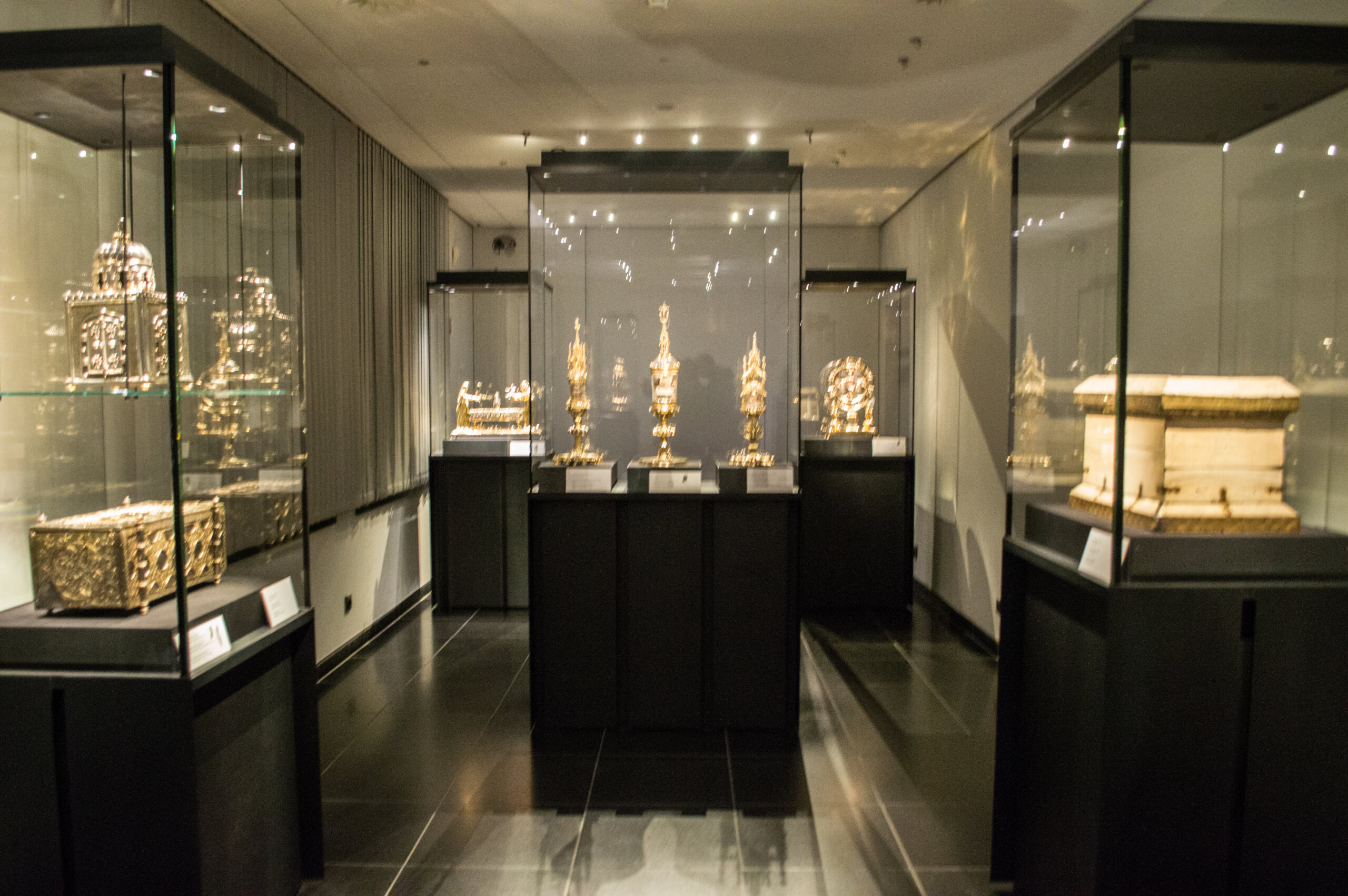
3. Aachen Town Hall (Aachener Rathaus)
Of course, while we’re appreciating glorious structures, the next spot on our Aachen must-do list is the Aachen Town Hall, a striking building that combines Gothic and Baroque styles.
While it’s pretty enough on the outside, try to organize a visit of the inside if possible. This way you’ll get to see the grand Coronation Hall (Krönungssaal) which was used for the coronation banquets of German kings. The walls are adorned with stunning frescoes depicting scenes from the life of Charlemagne and the history of the Holy Roman Empire.
The Town Hall is open daily for visitors, although there may be rooms that are inaccessible to visit if they’re in use. There are also guided tours (in German) on weekends from 10:30 – 11:30 am. Entry costs 6 Euro for adults and 3 Euro for concession, plus it’s free for anyone 21 or under!
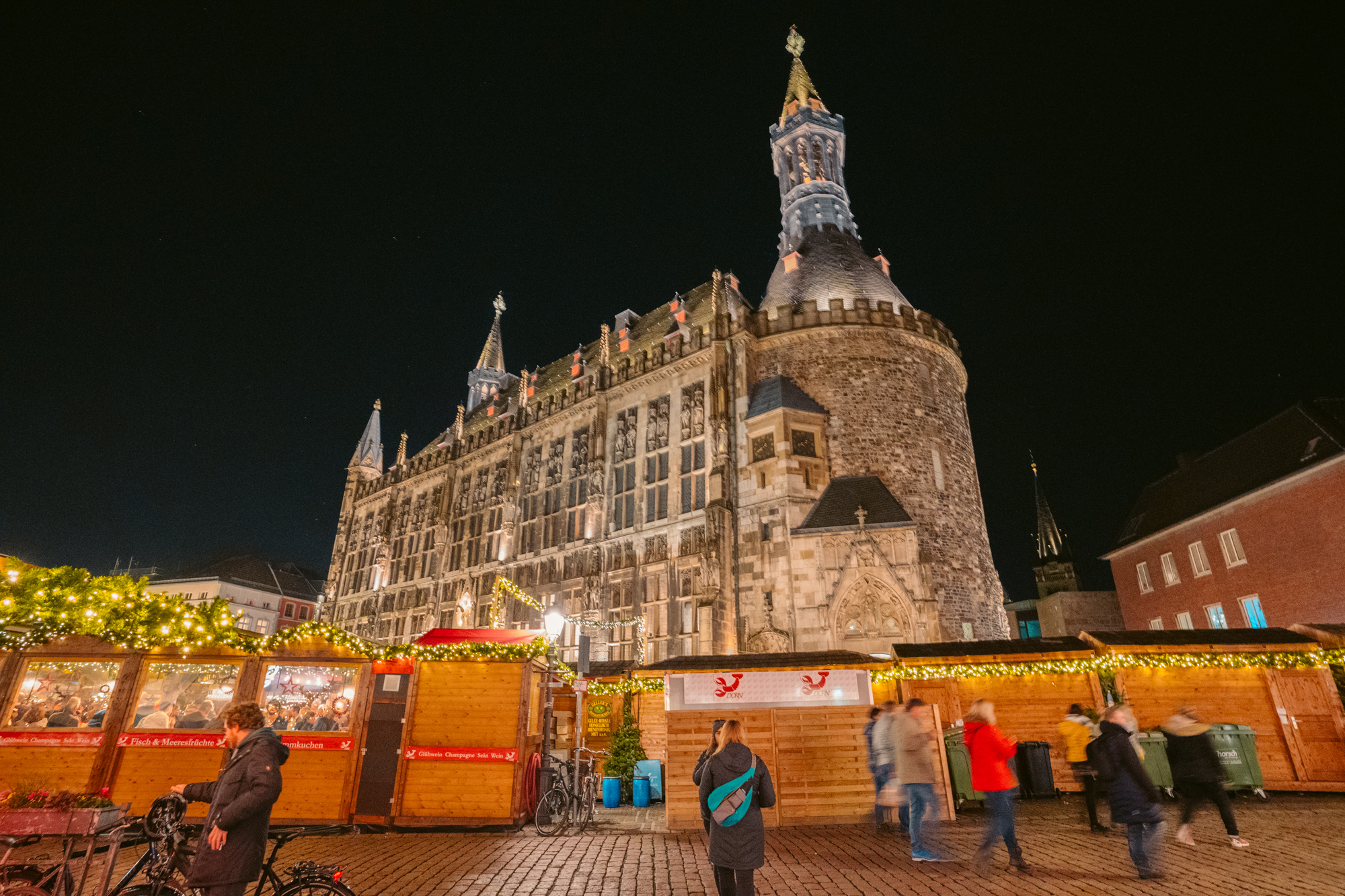
4. Elisenbrunnen
Now a big reason that Charlemagne was so keen on living in Aachen was thanks to its magical mineral springs, said to bring immeasurable health benefits. Today, these same springs are still active in the city, with the most obvious place to admire them being the Elisenbrunnen, a neoclassical pavilion built between 1822 and 1827.
Named after Princess Elisabeth Ludovika of Bavaria, the Elisenbrunnen was constructed to house and highlight the natural thermal springs. It features a grand colonnade with twelve Corinthian columns, while inside there are two pavilions that house the sulfur spring fountains. The interior walls are adorned with plaques listing notable visitors, including emperors, kings, and other prominent figures who have come to Aachen to enjoy the therapeutic waters.
It’s open 24 hours a day so you can easily walk in to have a look at the fountains and plaques whenever you want.
… prepare your noses however. Magical health water can smell a lot like boiled eggs.
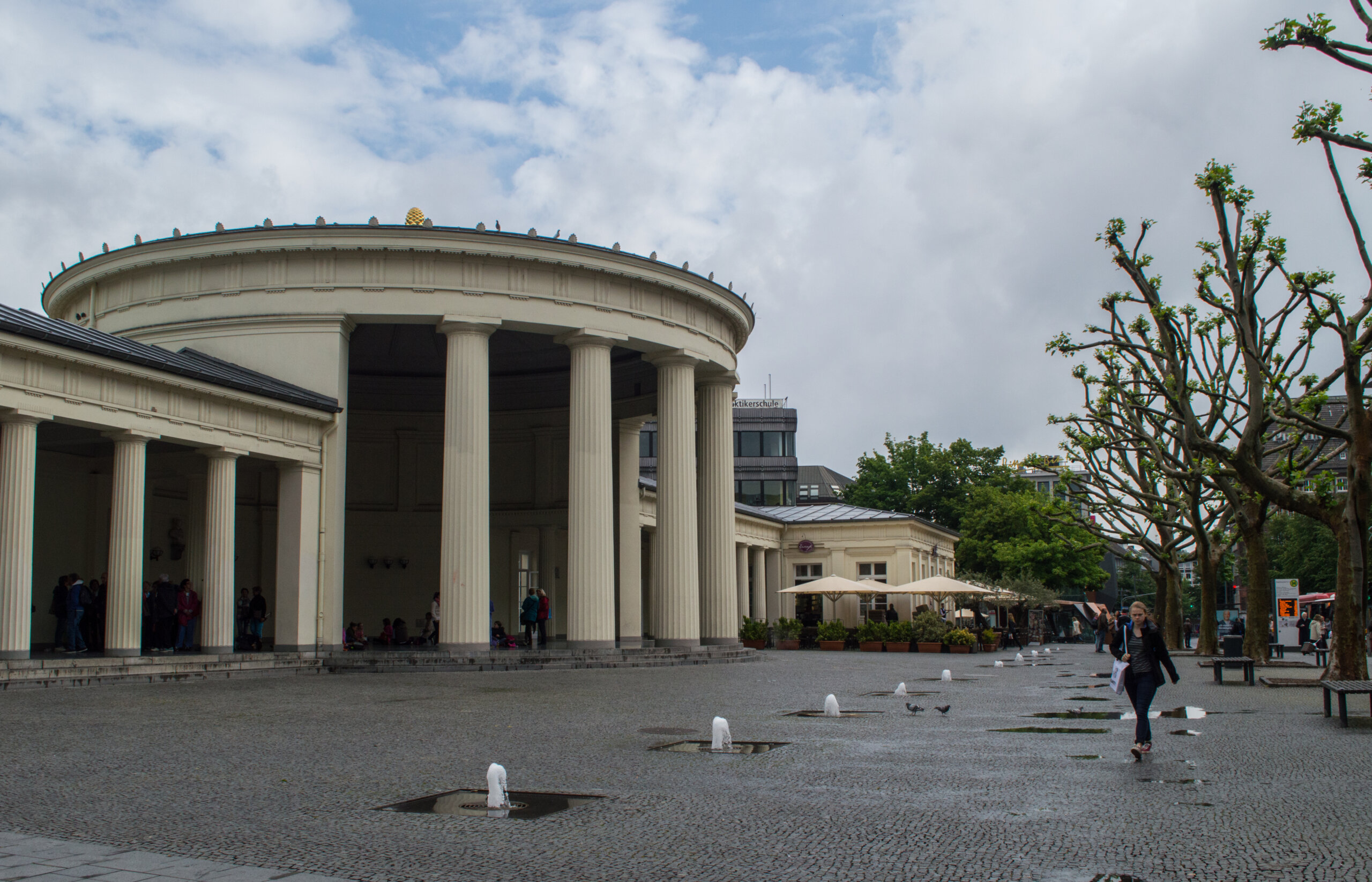
5. Carolus Thermen
And if your preference is to luxuriate and get pruny in those magical waters rather than just… look and smell them, then Carolus Thermen is another fun place to visit in Aachen.
This thermal bath and spa complex consists of a beautiful indoor thermal pool, outdoor pools and spa baths plus a whole “sauna world” consisting of hammams and saunas in log cabins! This would be a pretty incredible way to spend a relaxing day in Aachen, as there are also plenty of wellness and beauty treatments available as well, along with a restaurant on site.
Prices are also quite reasonable here, starting from 16 Euros for just the baths and 34 Euros for the baths and sauna. You can also visit for free if you come on your birthday (with ID proof)!
6. Amble around Altstadt
Aachen’s historic Altstadt (Old Town) is a charming place to explore, with store-lined streets weaving around the Cathedral and Town Hall – many of which are peddling souvenirs and the city’s signature Printen cookies. While many parts of Aachen are fairly modern and ordinary, the Altstadt still feels like a little step back in time, so make sure you explore a little.
Highlights include…
- Marktplatz: The main square which is surrounded by beautiful buildings (including the Town Hall) and also a pretty impressive fountain in the middle featuring a statue of Charlemagne. There’s also a local market held here on Thursdays
- Puppenbrunnen: A whimsical fountain with bronze puppets on it that have moveable parts – it’s weird but very cool!
- Aachen Theatre: While the original theatre was destroyed during WWII, it was rebuilt and reopened in 1951. This is the place to visit if you want to experience some opera, musical theatre or plays, plus it’s just a beautiful building as well (see below)
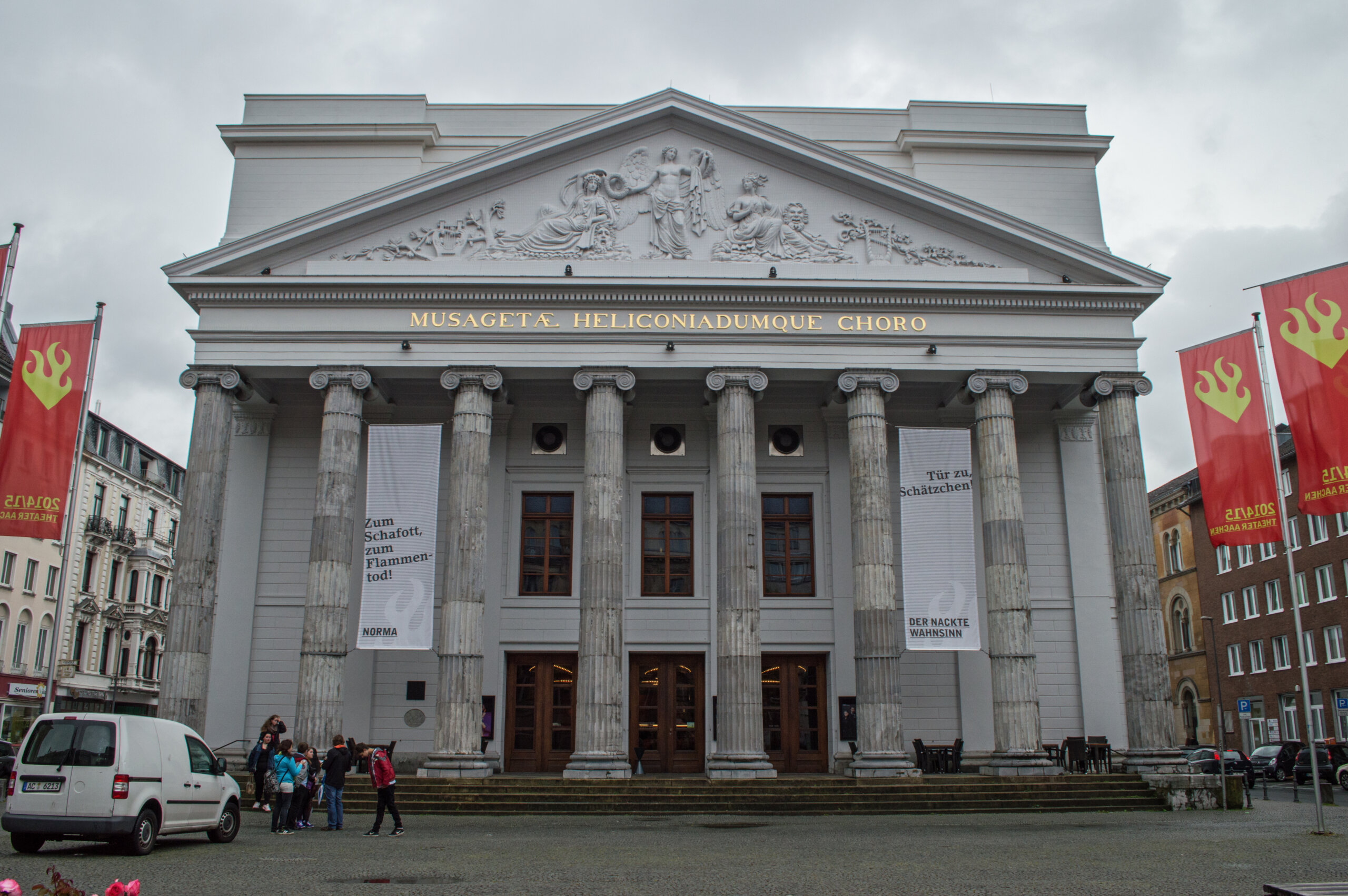
7. Suermondt-Ludwig-Museum
Looking for more culture-oriented things to do in Aachen?
The Suermondt-Ludwig-Museum is an art museum boasting an extensive collection of European paintings, sculptures, and decorative arts. These artworks span various periods and styles, including medieval art, renaissance paintings, baroque paintings, art from the 19th and 20th centuries as well as modern art.
Named after its founders, Barthold Suermondt and Irene and Peter Ludwig, this is the best spot in Aachen if you enjoy seeing lots of different types of artworks. Some of the most famous of these include pieces by Botticelli, Pieter Brueghel the Younger, Peter Paul Rubens, Caspar David Friedrich, Max Liebermann and Picasso.
8. Printen Museum
Or for a cultural experience of another kind, you learn about Aachen’s sweetest tradition at the Printen Museum, a museum solely dedicated to the local spiced biscuit called Printen.
Aachen Printen is a traditional German type of Lebkuchen, which is similar to gingerbread. The special Aachen version of these cookies originated around the 17th century when they were sweetened using honey. During Napoleon’s trade blockade in the 1800s the bakers in Aachen could no longer get honey, so they started sweetening their Printen with beet syrup instead.
Today the exact recipe is a closely guarded secret, but if you manage to organise a tour of the Printen Museum then you can learn all about these special biscuits. The museum can only be visited by booking a guided tour (you can find the contact info here) but you can also visit the Klein Printen Bakery shop if you just want to try some of the biscuit varieties!

9. Couven Museum
Another highlight of Aachen’s museum scene is the Couven Museum, an architectural and decorative arts museum showcasing the city’s history through a series of exquisitely furnished rooms.
Named after the renowned Aachen architect Jakob Couven, the museum is housed in a building that was once a 17th century pharmacy. The collection includes fine furniture, ornate porcelain, intricate silverware, and delicate glassware, all arranged to recreate the ambiance of a bygone era.
From the lavish Rococo salon to the more restrained Biedermeier rooms, each space tells a story of the evolving tastes and fashions of Aachen’s bourgeoisie. This is definitely a must-do if you enjoy feeling you’ve stepped back in time, or just want to get some photos while swanning about in the lavish interiors!
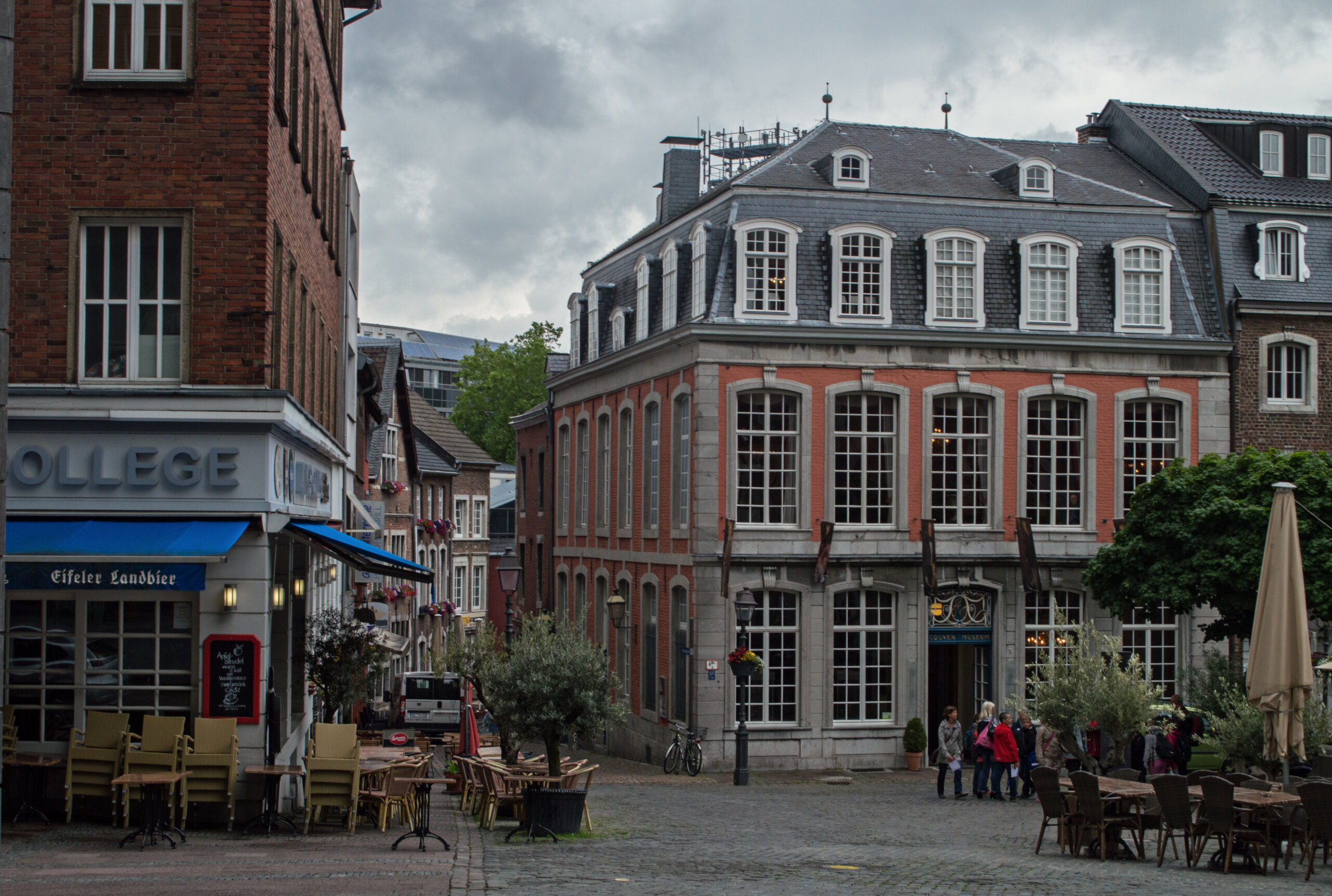
10. Marschiertor and Ponttor
Once upon a time, Aachen would have been fully fortified, with epic walls and gates as was common in most medieval cities. These days, only two remain – Marschiertor and Ponttor – but they’re worth hunting down to see.
The Marschiertor, built in the 13th century, is one of the oldest surviving city gates in Aachen. It was part of the city’s medieval fortifications and played a crucial role in protecting the southern entrance to the city. The Marschiertor is notable for its massive structure, with thick stone walls and a central gatehouse flanked by two imposing towers.
The Ponttor, also dating back to the 13th century, is another impressive gate located on the northern side of Aachen. Like the Marschiertor, it was an integral part of the city’s defenses. The Ponttor features a central passageway, originally designed for pedestrian and cart traffic, flanked by two round towers and topped with battlements.
They’re both about a ten-minute walk from the city centre (in opposite directions) but the Marschiertor is right by the main train station, so if you arrived in Aachen by train you can see that one then walk into the city to see the other sights and then further north to see the Ponttor as well.
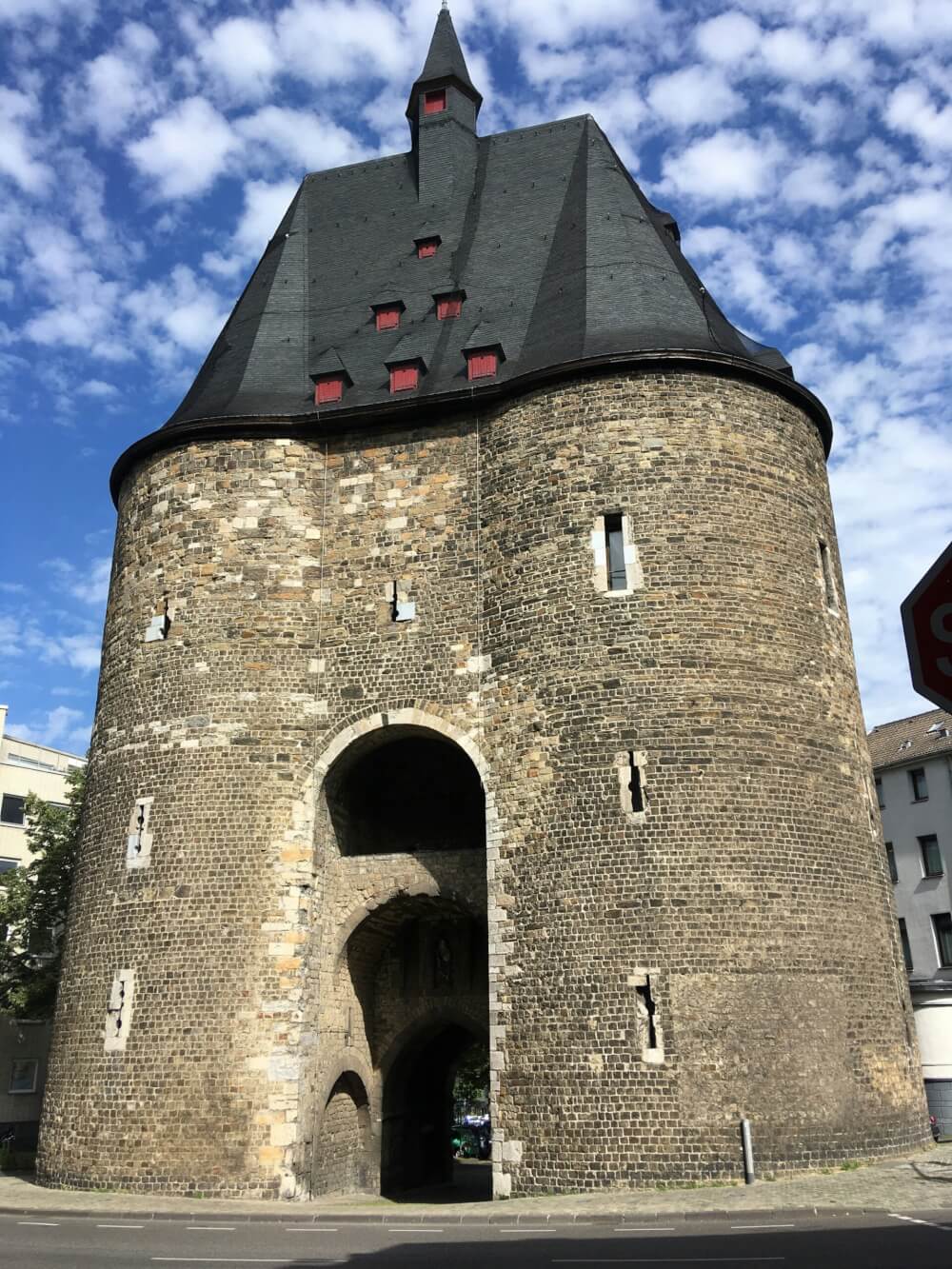
11. Lousberg
Looking for a more active challenge in Aachen? Consider hiking to the Lousberg, a local hill that offers panoramic views of the city.
Lousberg has a rich history that dates back to ancient times. According to legend, the hill was created by the devil who, frustrated in his attempt to flood Aachen with a bag of sand, dropped it here, forming Lousberg. In the 19th century, Lousberg became a popular recreational area for the residents of Aachen after it was landscaped with various paths and viewpoints.
Today it’s still a great place for walking, while also keeping your eyes peeled for sights such as the Belvedere Water Tower, Kersten Pavilion and a group of columns that were once part of the Belvedere Society House.
How to get there: Lousberg is easily accessible from Aachen’s city center. It is a short walk or bike ride away, and for those driving, there are parking areas at the base of the hill. Aside from walking around, it’s also a great spot for a picnic in nice weather.
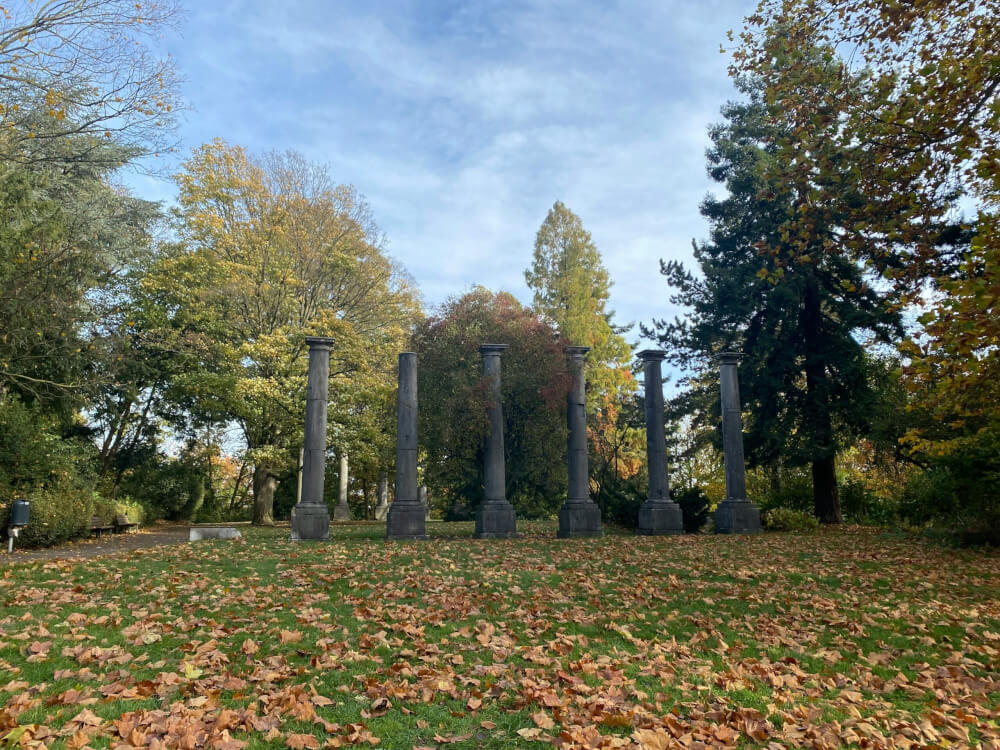
12. Aachen Forest (Aachener Wald)
And for those with some extra time, the Aachen Forest is a lovely green escape just 3.7 km from the city centre of Aachen.
Covering approximately 2,300 hectares, it is one of the largest urban forests in the region and offers a wide variety of flora and fauna for nature lovers to discover. The forest also provides many recreational activities to enjoy, including hiking, cycling, mountain biking, running and even horseback riding.
How to get there: The Aachen Forest is easily accessible from Aachen’s city center. There are multiple entry points and parking areas around the forest. You can also access parts of it by bus, the Aachen Entenpfuhler Weg station is a good spot to start, and can be reached by bus line 24 from outside the Aachen Schanz train station.
13. Dreiländereck (Three-Country Point)
Finally, 7km from the center of Aachen, you can also visit the Dreiländereck, where Germany, Belgium, and the Netherlands meet. This unique geographical point allows you to stand in all three countries at once, so if you’re into obscure bragging rights, this is definitely the place!
There’s also a big tower you can climb for views across all three countries (the tower is technically in Belgium), and a fun hedge maze “Labyrinth” on the Dutch side – along with a couple of spots for food and drink.
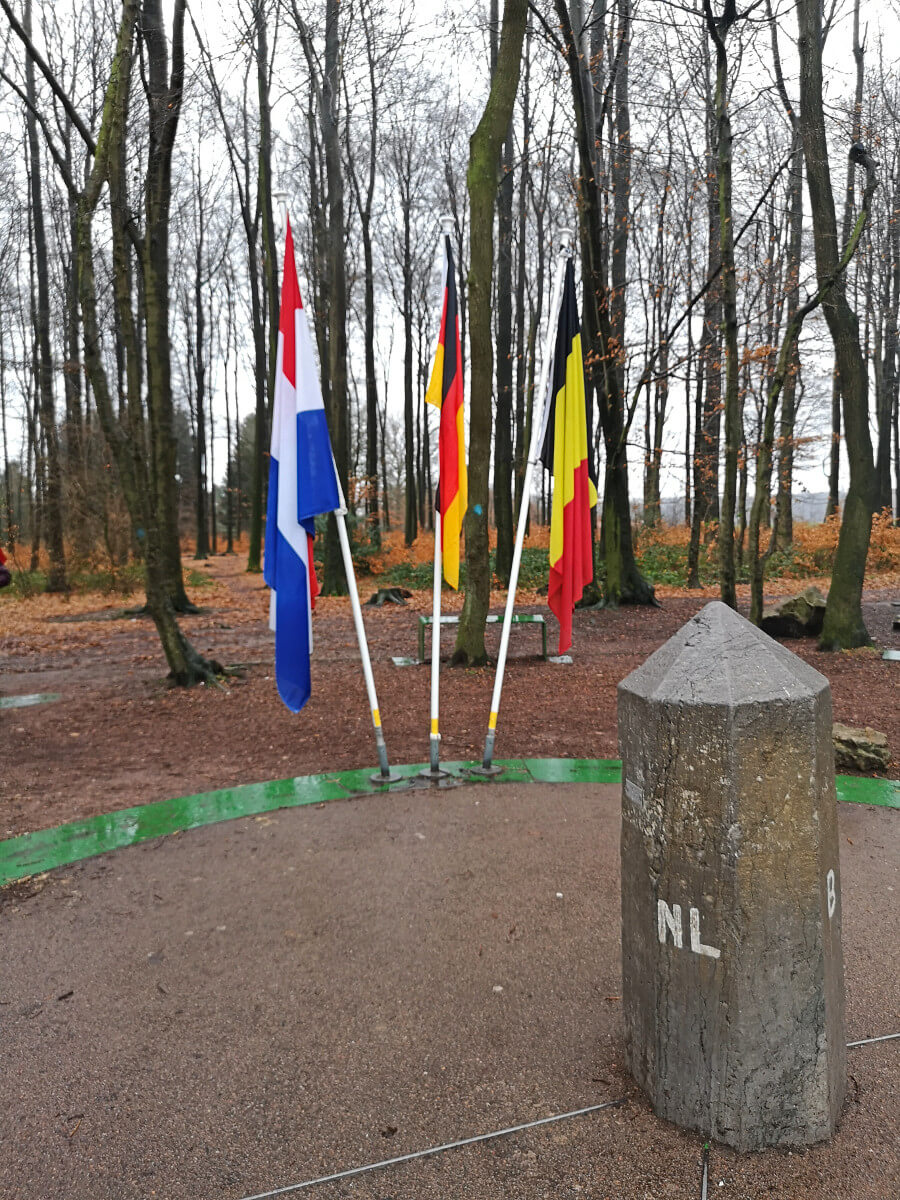
BONUS: Day Trip to Monschau
If you’re going to be visiting Aachen, then you may as well make the short trip to another one of the most picturesque spots in Germany – Monschau!
Monschau is less than an hour by car from Aachen (and around an hour by train), so it would make for a delightful day trip to see the famous crooked buildings, river, castle and other attractions. Read my guide all about the best things to do in Monschau if you need any more convincing.
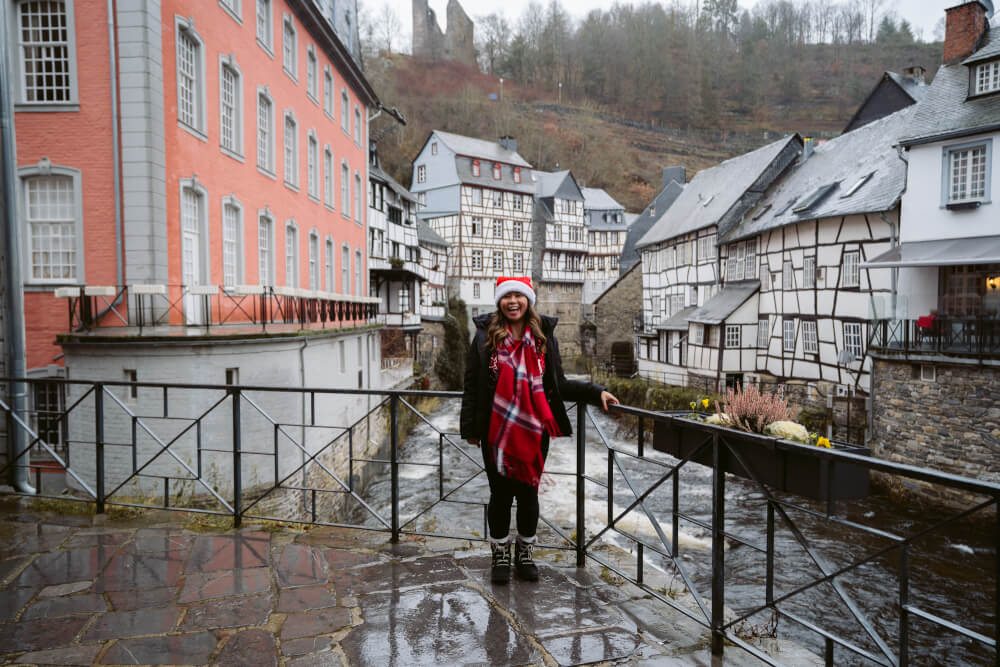
Did I miss any of your favourite things to do in Aachen?
Let me know in the comments so I can add more of the best Aachen activities to the list. Happy and safe travels! 🙂

